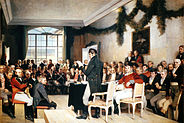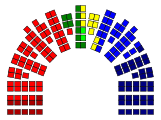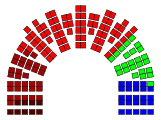- Media of Norway
-

Part of a series on
Norwegians
Culture Architecture · Art · Cinema · Cuisine
This article has no lead section. Please help by adding an introductory section to this article. For more information, see the layout guide, and Wikipedia's lead section guideline. (October 2009) Contents
Press
Reporters Without Borders ranks Norway 1st in its Worldwide Press Freedom Index, the same level as Iceland and Luxembourg. Freedom of the press in Norway dates back to the constitution of 1814. The Norwegian press is privately owned and self-regulated; however, the state provides press support.
Television
Main article: Television in NorwayThe two companies dominating the Norwegian terrestrial broadcast television are NRK (with four main services, NRK1, NRK2, NRK3 and NRK Super) and TV2 (with TV 2 Filmkanalen, TV 2 Nyhetskanalen, TV 2 Sport, TV 2 Zebra og TV 2 Bliss). Other, long-running channels are TVNorge and TV3.
Radio
National radio is dominated by the public-service company NRK, which is funded from the television licence fee payable by the owners of television sets. NRK provides programming on three radio channels – NRK P1, NRK P2, and NRK P3 – broadcast on FM and via DAB. A number of further specialist channels are broadcast exclusively on DAB, DVB-T, and the internet.
Additionally, there are a number of commercial radio stations as well as local radio stations run by various non-profit organizations.
Media bias
-
Distribution of mandates after the actual 2009 Norwegian parliamentary election:Socialist Left Party (11)Labour Party (64)Centre Party (11)Liberal Party (2)Conservative Party (30)Progress Party (41)
-
Distribution of mandates by Norwegian journalists sympathies before the 2009 Norwegian parliamentary election:Red (9)Socialist Left Party (33)Labour Party (78)Liberal Party (25)Conservative Party (24)
As with other related countries, the Norwegian media is often criticized of being biased towards the political left. This has been proven by political scientist Frank Aarebrot as being clearly true, in terms of both Norwegian journalists and editors.[1] Aarebrot has said that "it is serious when Norwegian journalists massively support the political left, but it is a bit more serious when it actually to a greater degree applies to Norwegian editors than among the journalists". He also expressed concern that journalists who sympathise with the Progress Party may have a lesser chance to get hired than journalists with political sympathies close to editors.[2]
For instance, in the actual 2009 election, the Progress Party received 41 mandates, while by journalists it would have received none. The Christian Democratic Party and Center Party would also have been left without representation, while the revolutionary socialist party Red would enter parliament with 9 mandates. The Socialist Left and Liberal Party would also receive significant gains.[1] In 2003, as much as 36% of Norwegian journalists said they would vote for the Socialist Left Party alone, with only 25% saying that they would vote for any of the right-of-center Liberal, Christian Democratic, Conservative or Progress Party combined.[2] News commentator Frank Rossavik once said that if a journalist would stand forward as a Progress Party voter, it would have been "social suicide", and more devastating than withdrawing from the Norwegian Union of Journalists.[3]
Norwegian editors have as well been proven to have leftist political views, with a 2008 survey showing that the Labour Party would have been given a majority in parliament alone with 85 representatives.[2]
The notion of political bias based on the sum of individuals' party selection has been criticized. Among others, conservative historian and politician Francis Sejersted holds that the general media is neither left-slanted nor right-slanted, but "media-slanted". This means that media across the political spectrum have a tendency to choose the same angle on a case, focusing on personification and dramatic events.[4]
Social media
Main article: social mediaAs of August 2009, it was estimated that 1,156,000 Norwegians use Facebook.[5] For comparison, the total number of inhabitants is about 4,830,000.
Film and cinema
Institutions
Institutions within organized labour are the Norwegian Union of Journalists, the Association of Norwegian Editors and the Norwegian Media Businesses' Association—these are organized in the umbrella Norwegian Press Association. The Press Association is responsible for Pressens Faglige Utvalg, which oversees the Ethical Code of Practice for the Norwegian Press. The Broadcasting Council oversees the state-owned Norwegian Broadcasting Corporation. The Norwegian Media Authority contributes to the enforcement government regulations.
Lists
- List of Norwegian newspapers
- List of Norwegian magazines
- List of Norwegian television channels
- List of Norwegian language radio stations
- List of Norwegian writers
- List of Norwegian companies
See also
- Communications in Norway
- Culture of Norway
References
- ^ a b Sletta, Kjell (7 May 2009). "Frp-fritt på Stortinget hvis journalister fikk bestemme". Dagbladet. http://www.dagbladet.no/2009/05/07/nyheter/innenriks/stortinget/journalister/media/6103098/.
- ^ a b c Løset, Kjetil (18 April 2008). "Redaktører vil ha Jens". TV2. http://www.tv2nyhetene.no/innenriks/politikk/redaktoerer-vil-ha-jens-1769680.html.
- ^ Rossavik, Frank (30 August 2007). "Venstrevridde journalister". Bergens Tidende. http://www.bt.no/meninger/kommentar/rossavik/article402128.ece?start=2.
- ^ Nore, Aslak (3 March 2004). "Konserntrusselen" (in Norwegian). Klassekampen. http://www.klassekampen.no/artikler/kultur_medier/9931/article/item/null. Retrieved 9 October 2009.
- ^ Jensen, Martin Huseby (7 August 2009). "68.000 på Twitter" (in Norwegian). Klassekampen. http://www.journalisten.no/story/58279. Retrieved 9 October 2009.
Further reading
- Encyclopedias
- Henriksen, Petter, ed (2007). "Norge – massemedier" (in Norwegian). Store norske leksikon. Oslo: Kunnskapsforlaget. http://www.snl.no/Norge/massemedier.
- Books
- Østbye, Helge (1984) (in Norwegian). Massemediene. Oslo: Tiden. ISBN 82-10-02375-6.
- Eide, Martin (1995) (in Norwegian). Blod, sverte og gledestårer. VG, Verdens Gang 1945-95. Oslo: Schibsted. ISBN 82-516-1557-7.
- Ottosen, Rune (1996) (in Norwegian). Fra fjærpenn til Internett. Journalister i organisasjon og samfunn. Oslo: Aschehoug. ISBN 82-03-26128-0.
- Allern, Sigurd (1997) (in Norwegian). Når kildene byr opp til dans. Søkelys på PR-byråene og journalistikken. Oslo: Pax. ISBN 82-530-1868-1.
- Dahl, Hans Fredrik (1999) (in Norwegian). Hallo - hallo! Kringkastingen i Norge 1920-1940 (2nd ed.). Oslo: Cappelen. ISBN 82-02-18478-9.
- Dahl, Hans Fredrik (1999) (in Norwegian). "Dette er London". NRK i krig 1940-1945 (2nd ed.). Oslo: Cappelen. ISBN 82-02-18577-7.
- Dahl, Hans Fredrik; Bastiansen. Henrik G. (1999) (in Norwegian). Over til Oslo. NRK som monopol 1945-1981. Oslo: Cappelen. ISBN 82-02-17644-1.
- Eide, Martin (2000) (in Norwegian). Den redigerende makt. Redaktørrollens norske historie. Kristiansand: IJ-forlaget. ISBN 82-7147-205-4.
- Allern, Sigurd (2001) (in Norwegian). Flokkdyr på Løvebakken. Søkelys på Stortingets presselosje og politikkens medierammer. Oslo: Pax. ISBN 82-530-2316-2.
- Allern, Sigurd (2001) (in Norwegian). Nyhetsverdier. Om markedsorientering og journalistikk i ti norske aviser. Kristiansand: IJ-forlaget. ISBN 82-7147-210-0.
- Ottosen, Rune; Røssland, Lars Arve; Østbye, Helge (2002) (in Norwegian). Norsk pressehistorie. Oslo: Samlaget. ISBN 82-521-5750-5.
- Eide, Elisabeth; Simonsen, Anne Hege (2008) (in Norwegian). Verden skapes hjemmefra. Pressedekningen av den ikke-vestlige verden 1902-2002. Oslo: Unipub. ISBN 978-82-7477-288-5.
- Bastiansen, Henrik; Dahl, Hans Fredrik (2008) (in Norwegian). Norsk mediehistorie (2nd ed.). Oslo: Universitetsforlaget. ISBN 978-82-15-01353-4.
Media of Europe Sovereign
states- Albania
- Andorra
- Armenia
- Austria
- Azerbaijan
- Belarus
- Belgium
- Bosnia and Herzegovina
- Bulgaria
- Croatia
- Cyprus
- Czech Republic
- Denmark
- Estonia
- Finland
- France
- Georgia
- Germany
- Greece
- Hungary
- Iceland
- Ireland
- Italy
- Kazakhstan
- Latvia
- Liechtenstein
- Lithuania
- Luxembourg
- Macedonia
- Malta
- Moldova
- Monaco
- Montenegro
- Netherlands
- Norway
- Poland
- Portugal
- Romania
- Russia
- San Marino
- Serbia
- Slovakia
- Slovenia
- Spain
- Sweden
- Switzerland
- Turkey
- Ukraine
- United Kingdom
- (England
- Northern Ireland
- Scotland
- Wales)
States with limited
recognition- Abkhazia
- Kosovo
- Nagorno-Karabakh
- Northern Cyprus
- South Ossetia
- Transnistria
Dependencies
and other territories- Åland
- Faroe Islands
- Gibraltar
- Guernsey
- Jan Mayen
- Jersey
- Isle of Man
- Svalbard
Other entities Categories:- Norwegian media
-
Wikimedia Foundation. 2010.


